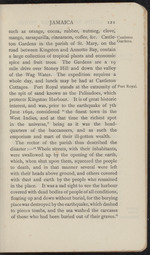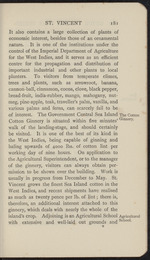| 1 |
 |
“...JAMAICA 121
such as orange, cocoa, rubber, nutmeg, clove,
mango, sarsaparilla, cinnamon, coffee, &c. Castle- Castleton
ton Gardens in the parish of St Mary, on the Gardens-
road between Kingston and Annotto Bay, contain
a large collection of tropical plants and economic
spice and fruit trees. The Gardens are a 19
mile drive over Stoney Hill and down the valley
of the Wag Water. The expedition requires a
whole day, and lunch may be had at Castleton
Cottages. Port Royal stands at the extremity of Port Royal,
the spit of sand known as the Palisadoes, which
protects Kingston Harbour. It is of great historic
interest, and was, prior to the earthquake of 7th
June 1692, considered “the finest town in the
West Indies, and at that time the richest spot
in the universe,” being as it was the head-
quarters of the buccaneers, and as such the
emporium and mart of their ill-gotten wealth.
The rector of the parish thus described the
disaster“ Whole streets, with their inhabitants,
were swallowed up by...”
|
|
| 2 |
 |
“...contains a large collection of plants of
economic interest, besides those of an ornamental
nature. It is one of the institutions under the
control of the Imperial Department of Agriculture
for the West Indies, and it serves as an efficient
centre for the propagation and distribution of
important industrial and other plants to local
planters. To visitors from temperate climes,
trees and plants, such as arrowroot, banana,
cannon-ball, cinnamon, cocoa, clove, black pepper,
bread-fruit, india-rubber, mango, mahogany, nut-
meg, pine-apple, teak, traveller’s palm, vanilla, and
various palms and ferns, can scarcely fail to be
of interest. The Government Central Sea Island The Cotton
Cotton Ginnery is situated within five minutes’Glnnery'
walk of the landing-stage, and should certainly
be visited. It is one of the best of its kind in
the West Indies, being capable of ginning and
baling upwards of 4000 lbs. of cotton lint per
working day of nine hours. On application to
the Agricultural Superintendent...”
|
|
